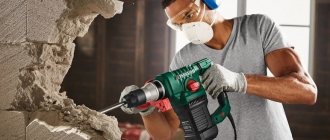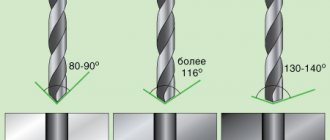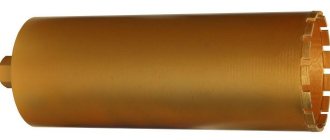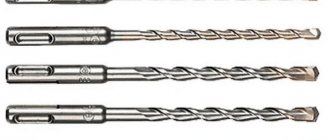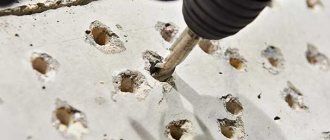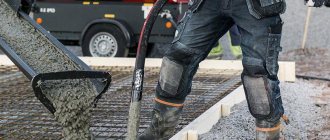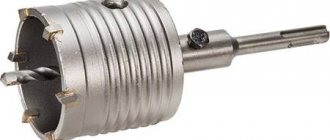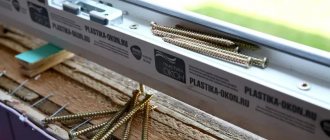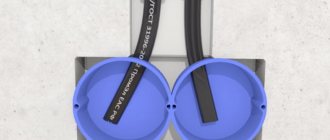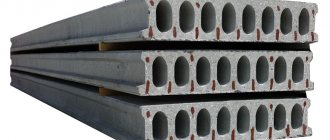During construction or renovation, it is often necessary to drill holes in concrete and stone with a hammer drill. In order for the drilling process to proceed quickly, it is necessary to select the correct concrete drill for the hammer drill. Many people mistakenly think that they can make holes in such material with simple drills. But in fact, during the drilling process, ordinary consumables quickly bend and become dull. This article will discuss the criteria for choosing a drill for a hammer drill. To make it easier to understand, the most popular blastholes from well-known world brands will be listed today.
Types of boreholes
What is different about a concrete drill?
It has a special brazing made of a reliable alloy with a hardness level comparable to diamond. We are talking about victorious coating.
Equipment for drilling element for concrete:
- Can be used in conjunction with a drill. The design of the drill is distinguished by the presence of a tail with a cylindrical or multifaceted shape;
- For a hammer drill. It is made in a shape similar to a shank or cylinder. For marking, the inscription SDS PLUS or SDS MAX is used.
How are drills marked and what sizes of nozzles are there?
Before inserting a drill into a hammer drill, you should make sure that you purchased a consumable with the type of shank recommended by the manufacturer (that is, all holes and shapes match the mount). Professionals advise choosing shanks with SDS fastening. It makes it possible to quickly change equipment and comes in 5 types:
- SDS plus is distinguished by the presence of 4 grooves with a diameter of 10 mm. The drills themselves can have a diameter of at least 0.4 cm and a maximum of 2.6 mm. They work great on concrete bases;
- SDS has 2 grooves, diameter 10mm;
- SDS max has five slots and is used for fastening powerful drills in rotary hammers for professional work. The diameter of the equipment increases from 2 to 8 cm;
- SDS top is distinguished by the presence of 4 grooves with a diameter of 1.4 cm. The size of the nozzles for this mount varies from 1.6 cm to 2.5 cm. This equipment is used in medium-weight hammer drills.
- The longitudinal projections in the SDS quick mount seem to have affected their popularity. They are rarely found on store shelves.
In addition to the type of fastening, the type of work to be done should influence the purchase of a particular consumable. Drill sizes for simple household work are limited to 6-10 mm.
Choosing a blade for a hacksaw for metal: rating the best blades, choosing and using the best tool- Review of diamond bits for concrete: subtleties of choosing and using tools for high-quality drilling
- The best concrete drills for drills and hammer drills: tips for choosing, structure and types of tools
If you need to screw an anchor bolt into the wall, you will need to take equipment of at least 2 and no more than 20 mm.
Another indicator of the drill size is the length of the working part and the main length. For private construction, where thick partitions are almost always erected, both a modest 10 cm nozzle and professional meter-long equipment may be required.
The walls in apartments are much thinner, and for standard repair work a 6 mm drill with a length of 110 mm will be sufficient.
To summarize, we can say that the choice of consumables for a hammer drill is made after assessing the scale and complexity of the upcoming work.
How to drill through reinforced concrete?
If you use an impact drill model for concrete based on reinforced concrete, then nothing will work. To do this, you will have to use a hammer drill with a special type of impact drill for concrete; it is also called a drill for this dense material.
Special drill for reinforced concrete:
- Screw type. They help create holes with increased depth;
- Twist drills. Help create large holes;
- Gentle views. Suitable for creating holes with a small diameter and shallow depth.
To use such drills based on an impact drill or hammer drill, you need to fix them in the drive part of the chuck.
To facilitate installation, the drill design has a thickening at the tip. We are talking about professional equipment. It allows you to create holes with a diameter of around 4 mm and up to 3 cm.
Using a crown on concrete
If a particularly large hole with a large diameter is required, then the use of a core tool for working with concrete is beneficial. This device will help create a recess based on a diameter of 12 cm in high-strength materials.
Core drill options:
- Diamond modification. Outwardly it looks like a tube or crown fixed to a rod. Diamond coating has been added to the edges;
- Pobedit version. Manufactured as a nozzle. It has an identical structure. But instead of diamond coating, pobedite teeth are used.
A core drill for concrete is used when it is necessary to prepare a recess for mounting an outlet or switch.
Important: To select the right device and drill for working with reinforced concrete, it is necessary to take into account the density of the material and the required size, depth, width of the hole.
The diameter of the drill in the end may be around 4 - 12 mm or more with a length from 50 mm to 1,000 mm. Therefore, it is clear that to create a large hole, larger and longer drills are required for working with reinforced concrete.
How to choose a drill for concrete?
For example, a drill based on an impact drill can penetrate lightweight types of concrete: aerated concrete, foam concrete, expanded clay concrete. But there is a very important nuance. The model of the selected equipment must have the “impact drilling” function.
Thanks to this, it is possible to create holes in the considered type of solid material and the average level of concrete.
- But, if you need to create a hole in beams, columns, or tiled floors, such equipment will not be suitable, since in this case reinforcement is used on the inside of the material.
- To cope with this task, it is worth studying the capabilities of various hammer drills equipped with the appropriate drill. The problem is that a standard drill will not be able to provide the impact force to work with such material.
These points must be taken into account when choosing a device and drill to perform the job reliably.
Drills for metal processing
Hammer drills, designed to create holes in metal products, differ both in material and design. Most of these hammer drills have a spiral design and a cylindrical shank.
The material of manufacture and the design of the tool have a great influence on both the quality and efficiency of the processing performed.
- Drills made from cobalt alloys are optimally suited for creating holes in high-strength steel products.
- Extra-long tools are used to drill holes in products made of aluminum and other non-ferrous metals.
- The most universal types of drills used for drilling metal using a hammer drill are tools whose cutting part is equipped with hard alloy plates.
Apart from very expensive professional-grade universal drills, you have to drill metal with a hammer drill using attachments with a cylindrical shank, for which it is useful to have an appropriate adapter
Recommendations for working with concrete
A quality choice of equipment and drill does not guarantee a positive result. You must be able to use the selected device correctly.
Helpful Tips:
- Before starting work, you should prepare the device and a set of drilling elements. It is important to realize that creating a hole with the required diameter requires the appropriate drill and equipment. Therefore, it is necessary to have different models to solve any problem;
- If during operation the drill hits the reinforcement, then it is beneficial to change the drill to a model for drilling metal. But this problem can be solved by pre-sharpening the drill. This way you don’t have to interrupt work to replace the drilling element;
- During operation, it is important to prevent the drill from overheating. Therefore, you should take a short break every 15 seconds. But for this you should use the natural cooling process. There is no need to pour water or other liquid over the drill, as it may become damaged;
- In the case of a meeting with a very hard stone, it is beneficial to have a chipper in your arsenal. It will help crush the obstacle to make room for the drill to work;
- It is not recommended to use an impact drill on a load-bearing wall or ceiling. It will not help in creating a hole with the required diameter and depth. In this case, it is more profitable to use a hammer drill;
- If you are making a hole in ceramics, then you should also use equipment for concrete. But with one difference, you need to turn off the shock mode, this will help maintain the integrity of the tile;
- If during operation the drill has noticeably deteriorated or become dull, then to restore factory characteristics it can be processed with a grinder in combination with a diamond disc. But when using an expensive and high-quality drill, such situations usually do not occur. Therefore, it is profitable to purchase professional equipment. It is more expensive, but there are fewer unexpected problems with it.
Now we understand how a drill for working with concrete differs and what equipment it is used with. We understood the advantages of a core drill for this hard material.
We looked at the aspects that need to be paid attention to in the process of choosing a drill and the corresponding device. To simplify the work process, many useful tips have been offered. Therefore, now we have enough information to create a hole based on this material.
General classification
Among concrete drills for rotary hammers, there are tools made from steel alloys of various categories:
- alloyed;
- high-speed;
- carbonaceous.
In cases where a hammer drill is used to create holes in particularly durable materials (such as granite), drills equipped with carbide cutting plates can be installed on it.
For particularly heavy drilling, a punch drill is suitable, featuring a very specific working head.
The type of processing of the tool during its production also has a significant influence on the characteristics of a hammer drill. Contrary to popular belief, drills with a black surface do not have the highest strength, but their wear resistance is excellent. During the production process, such drills are exposed to superheated steam, which gives them such characteristics. Drills with a golden-colored surface are more durable. Such a tool is less susceptible to chipping and breaking, since during the production process it is subjected to a procedure for relieving internal stress.
The drill shank for a hammer drill can have different diameters, different numbers and sizes of recesses
To perform the most complex jobs, hammer drills of the SDS-max category are used, which are often called “Maksovskie”. For installation on such hammer drills, drills are used, the cutting part of which is equipped with a four-leaf type carbide brazing. Due to the fact that the petals are soldered into a metal base, they do not fly off during processing and are characterized by very high rigidity and reliability. A feature of drills of this type, which allow drilling at high speeds, is also the presence in their design of a double parabolic helix, which is responsible for simultaneous solution of several tasks:
- quick removal of dust generated during the drilling process;
- preventing tool deformation when exposed to lateral loads;
- reduction of drill vibration level.
Concrete drill MAKITA-SDS-Max
Drills of this type are produced in a fairly wide range of working diameters (from 16 to 40 mm), and their length can be 250, 450, 550, 800 and 1200 mm.
However, the best characteristics are found in hammer drills, the surface of which is painted in a bright golden color. This type of drill is endowed with these properties by being coated with wear-resistant titanium nitride.
Experienced specialists who constantly use rotary hammers in their work can easily evaluate the quality of a drill by performing processing with it. In particular, if the tool heats up intensely during drilling, this means that the manufacturer did not sharpen it correctly.
Using drills mounted on a hammer drill, you can process materials such as:
- wood;
- glass;
- metal;
- plastic;
- tile;
- concrete.
Twist drill for wood
According to the nature of the tasks that need to be solved, drills installed on rotary hammers are divided into the following categories:
- crown-type tools (for forming a high-quality hole of significant diameter in the material being processed);
- twist drills (the most versatile tool used to create holes in materials with different internal structures);
- Feather-tipped drill bits, which are ideal for drilling holes in loose materials such as wood;
- step-type drills used for drilling metal products of small thickness, as well as structures made of ondulin and other thin-walled materials;
- gun drills, etc.
When choosing drills for a hammer drill for concrete or other materials, you should pay attention to the tool shank. This recommendation is due to the fact that the drill shank and the design of the hammer drill chuck may not correspond to each other.
To connect other types of nozzles, a variety of adapters are used
